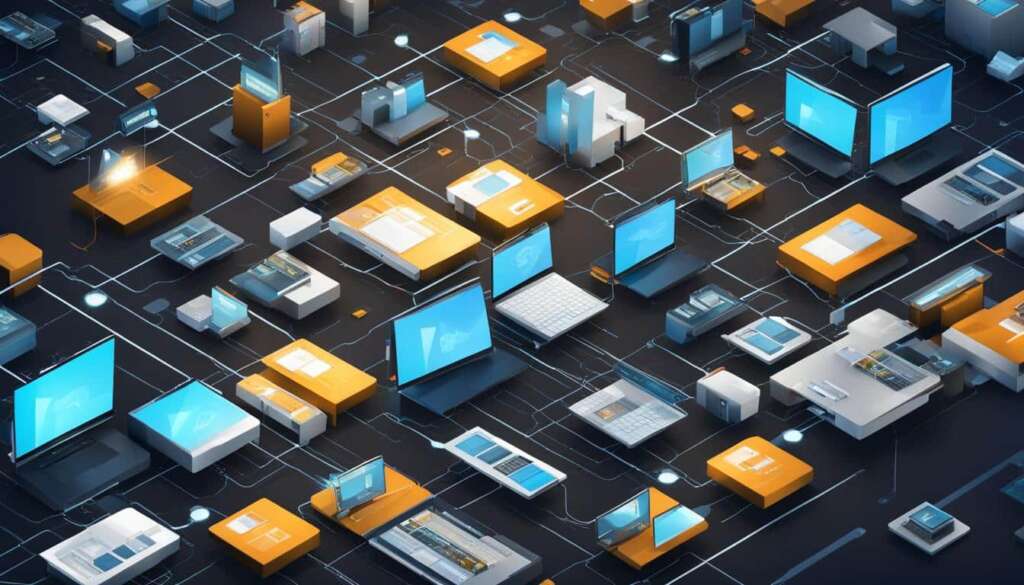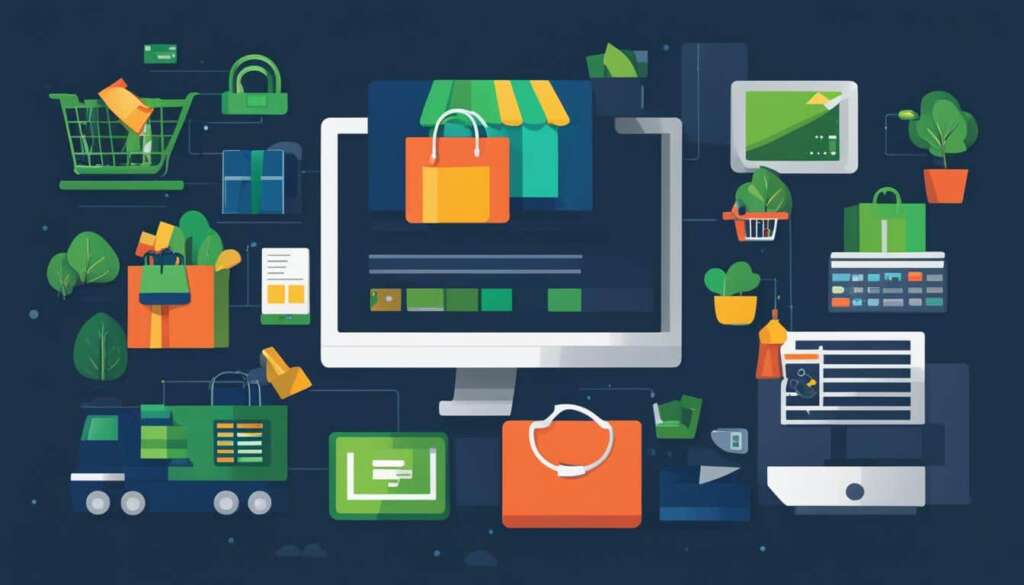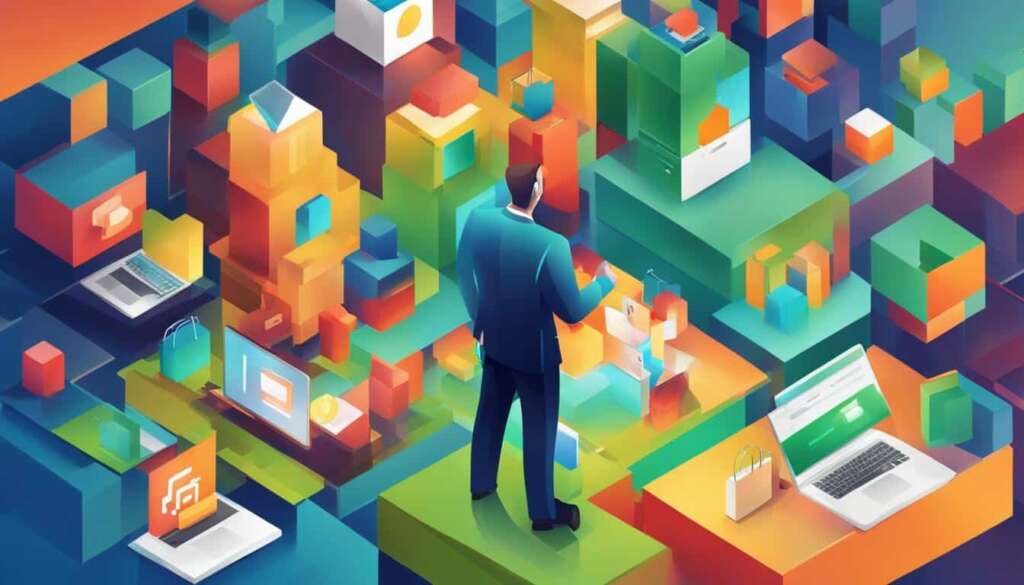Table of Contents
E-commerce, or electronic commerce, is a term that refers to the digital buying and selling of goods and services over electronic networks like the internet. This revolutionary form of commerce has had a significant impact on global trade and has transformed the way we shop and do business.
When we talk about e-commerce, we are referring to not only the exchange of products and services but also the transmission of funds or data through electronic channels. This includes transactions conducted between businesses (B2B), businesses and consumers (B2C), consumers and other consumers (C2C), and consumers and businesses (C2B).
Online platforms like Amazon and eBay have played a major role in the growth of e-commerce, making it easier for businesses and individuals to engage in digital commerce. In fact, e-commerce accounted for 16.5% of retail sales in Q2 2020, highlighting its significant presence in the retail landscape.
Now that we understand the definition of e-commerce and its impact on global trade, let’s delve deeper into how e-commerce works and explore the different types of e-commerce models in the following sections.
How Does E-Commerce Work?
In the world of e-commerce, customers utilize their own devices to access online stores, where they can browse through a wide range of products and services and place their orders. The process begins when the customer’s web browser connects with the server hosting the e-commerce website to initiate the order processing.
Once the order is placed, the relevant data is transmitted to an order manager, which then forwards it to different databases responsible for inventory management, payment processing applications, such as PayPal, and the bank’s computer system. The information undergoes validation to ensure the accuracy of the order.
Upon successful validation, the order manager notifies the web server, which displays a message to the customer, confirming the order. Simultaneously, the order data is sent to the warehouse or fulfillment department, where the product is prepared for shipping or access is granted to the service.
This entire process involves multiple stages and systems working together seamlessly to enable smooth e-commerce transactions, from order placement to inventory management, payment processing, and shipping. It highlights the complexity of the behind-the-scenes operations that contribute to the convenience and functionality of online stores.
Example Process of E-Commerce Transaction:
| Stage | Description |
|---|---|
| 1 | Customer accesses the online store through their device. |
| 2 | Customer selects products or services and proceeds to check out. |
| 3 | Web browser communicates with the server hosting the e-commerce website. |
| 4 | Data is relayed to the order manager and then forwarded to different databases for processing. |
| 5 | Order data undergoes validation for accuracy. |
| 6 | Order manager notifies the web server, displaying a confirmation message to the customer. |
| 7 | Order data is sent to the warehouse or fulfillment department for shipping or service access. |
Understanding the intricacies of e-commerce operations sheds light on the extensive behind-the-scenes processes that facilitate smooth and efficient online transactions. From inventory management to payment processing and shipping, each step plays a crucial role in ensuring a seamless shopping experience for customers.
Types of E-Commerce
In the world of e-commerce, various models exist to facilitate transactions between different entities. Let’s explore the main types of e-commerce and the key players involved.
1. Business-to-Business (B2B)
B2B e-commerce involves the exchange of goods, services, or information between businesses. It caters to the needs of companies by enabling them to engage in online transactions with their suppliers, distributors, or partners. This form of e-commerce streamlines procurement processes and enhances efficiency within the business ecosystem.
2. Business-to-Consumer (B2C)
B2C e-commerce refers to the direct selling of products, services, or information from businesses to individual consumers. This model encompasses online retail platforms like Amazon, where consumers can make purchases conveniently from the comfort of their homes. B2C e-commerce has revolutionized the shopping experience, offering a vast array of products and personalized recommendations.
3. Consumer-to-Consumer (C2C)
C2C e-commerce enables consumers to trade products, services, or information with one another. Platforms like eBay and Craigslist provide an avenue for individuals to buy and sell pre-owned items, fostering a peer-to-peer marketplace. Additionally, social media platforms such as Facebook Marketplace and Depop facilitate C2C transactions by connecting buyers and sellers.
4. Consumer-to-Business (C2B)
C2B e-commerce flips the traditional dynamics by allowing consumers to offer their products or services to businesses. This model is commonly seen in freelance platforms, where individuals can showcase their expertise and businesses can bid on their services. C2B e-commerce empowers consumers to monetize their skills and cater to the demands of companies.
5. Business-to-Administration (B2A)
B2A e-commerce involves online transactions between businesses and government bodies. This type of e-commerce facilitates interactions related to legal documents, registers, and employment. For instance, businesses may submit tax filings or obtain licenses through digital platforms provided by government agencies.
6. Consumer-to-Administration (C2A)
C2A e-commerce refers to online transactions between individuals and government organizations. It encompasses services such as Social Security registration, tax payments, and healthcare-related activities. C2A e-commerce streamlines processes, allowing individuals to conveniently access and engage with government services online.
7. Mobile Commerce (m-commerce)
Mobile commerce, commonly known as m-commerce, focuses on online sales transactions conducted using mobile devices like smartphones and tablets. With the widespread adoption of mobile technology, businesses have adapted their e-commerce platforms to cater to the growing number of mobile users. M-commerce offers convenience and flexibility, allowing consumers to shop anytime and anywhere.
Understanding the different types of e-commerce models is crucial for businesses and consumers alike. Each model serves a specific purpose and caters to unique transactional needs. As the e-commerce landscape continues to evolve, businesses and individuals must stay informed and adapt to embrace the potential of digital commerce.
Advantages of E-Commerce
E-commerce offers numerous advantages that have transformed the way people shop and conduct business. From the convenience of 24/7 availability to a wide selection of goods and services, e-commerce provides a seamless and accessible shopping experience. With its international reach and lower costs compared to traditional brick-and-mortar stores, e-commerce has revolutionized the retail landscape.
Availability and Accessibility
One of the key advantages of e-commerce is its availability and accessibility. Unlike physical stores with limited operating hours, e-commerce platforms are accessible 24/7. Customers can browse and purchase products or services at their own convenience, without any geographical constraints. This allows businesses to reach a global customer base and ensures that consumers can shop anytime, anywhere.
Selection of Goods and Services
E-commerce platforms offer a vast selection of goods and services that cater to diverse customer needs. Whether it’s clothing, electronics, or even specialized niche products, e-commerce provides a one-stop-shop for customers to find what they’re looking for. Additionally, e-commerce allows businesses to easily expand their product offerings without the limitations of physical shelf space.
International Reach
E-commerce has enabled businesses to expand their reach beyond local markets and tap into the global marketplace. With e-commerce, companies can easily sell their products or services to customers in different countries, breaking down geographical barriers. This international reach opens up new opportunities for growth and revenue for businesses of all sizes.
Convenience
The convenience factor of e-commerce cannot be overstated. Customers can browse products, compare prices, and make purchases from the comfort of their own homes or while on the go. The ease of online shopping eliminates the need for physical travel and long queues, saving time and effort. Additionally, e-commerce platforms often provide personalized product recommendations based on customer data, enhancing the overall convenience and tailored shopping experience.
Lower Cost
E-commerce offers cost advantages compared to traditional brick-and-mortar stores. Businesses can save on expenses such as rent, utilities, and staffing. These cost savings can be passed on to customers, resulting in attractive pricing options. Customers also benefit from reduced travel expenses associated with shopping at physical stores. Overall, e-commerce provides a cost-effective solution for both businesses and consumers.
By harnessing the power of e-commerce, businesses can tap into a global customer base, provide convenience, and offer a wide range of products and services. With the advantages of availability, accessibility, selection, international reach, convenience, and lower cost, e-commerce continues to shape the future of retail and revolutionize the way we shop.

Disadvantages of E-Commerce
E-commerce offers numerous benefits, but it also comes with its fair share of disadvantages. Let’s explore some of the downsides that consumers may encounter when engaging in online shopping.
1. Limited Customer Service
One of the drawbacks of e-commerce is the limited customer service compared to physical stores. While many online retailers provide customer support through chatbots or email, the absence of face-to-face interaction can be frustrating for some customers who prefer personalized assistance or immediate resolution to their queries.
2. Inability to Touch Products
In a physical store, customers have the opportunity to touch, feel, and examine products before making a purchase. This sensory experience is absent in e-commerce, making it challenging for customers to assess the quality, texture, and fit of a product solely based on product descriptions and images.
3. Wait Time for Shipping
When shopping in physical stores, customers have the convenience of instantly obtaining their purchases. However, in e-commerce, there is typically a wait time for shipping. Depending on various factors such as the customer’s location, availability of the product, and the efficiency of the logistics provider, the delivery process can vary in duration, resulting in delayed satisfaction.
4. Security Concerns
The rise of e-commerce has brought about security concerns for both businesses and consumers. Online transactions involve sharing personal and financial information, which can be vulnerable to cyberattacks, fraud, or data breaches. Although e-commerce platforms implement security measures, such as encryption and secure payment gateways, the risk of security breaches is an ongoing concern.
“E-commerce offers convenience and accessibility, but it’s essential for consumers to be aware of the potential drawbacks and take necessary precautions to protect their privacy and security.” – Retail Expert, Sarah Thompson
Overall, it’s important for consumers to weigh the advantages and disadvantages of e-commerce before making purchasing decisions. While the limitations of customer service, inability to physically touch products, wait time for shipping, and security concerns exist, they can be mitigated by careful research, reading reviews, and shopping from reputable online retailers.
However, e-commerce continues to evolve and improve, addressing these concerns with innovative solutions such as augmented reality for virtual product experiences and enhanced security measures to protect customer data. As these advancements continue, e-commerce will likely become an even more seamless and secure shopping experience in the future.
Conclusion
In summary, e-commerce, or electronic commerce, has transformed the way people buy and sell goods and services. Its widespread popularity has revolutionized the retail industry, offering convenience, accessibility, and global reach to consumers worldwide. Despite its limitations in terms of customer service and security concerns, e-commerce continues to reshape the way we shop.
Looking ahead, the future of e-commerce is promising. As technology advances, we can expect e-commerce to evolve even further, incorporating innovations such as augmented reality (AR) and virtual reality (VR) to enhance the online shopping experience. The integration of artificial intelligence (AI) and machine learning (ML) will enable personalized product recommendations and tailored shopping experiences.
Furthermore, the COVID-19 pandemic has accelerated the adoption of e-commerce, making it an essential component of businesses’ strategies. The shift towards online shopping is expected to persist even beyond the pandemic, with consumers embracing the convenience and safety of e-commerce.
In conclusion, e-commerce has forever changed the retail landscape, and its impact will continue to be felt in the future. As businesses adapt and leverage the potential of e-commerce, the digital marketplace will thrive, offering consumers endless opportunities to connect, shop, and transact in the online world.
FAQ
What is e-commerce?
E-commerce, or electronic commerce, refers to the online buying and selling of goods and services.
How does e-commerce work?
In e-commerce, customers use their own devices to access online stores, browse products and services, and place orders. The order is processed by the server hosting the e-commerce website, which relays the order data to an order manager for inventory management, payment processing, and validation. After validation, the order manager notifies the web server, and the order data is sent to the warehouse or fulfillment department for product dispatch or service access.
What are the main types of e-commerce?
The main types of e-commerce include business-to-business (B2B), business-to-consumer (B2C), consumer-to-consumer (C2C), consumer-to-business (C2B), business-to-administration (B2A), consumer-to-administration (C2A), and mobile commerce (m-commerce).
What are the advantages of e-commerce?
Some advantages of e-commerce include its 24/7 availability, quick access to products and services, wide selection of goods, easy accessibility, international reach, lower operating costs compared to physical stores, and the ability to provide personalized product recommendations based on customer data.
What are the disadvantages of e-commerce?
Some disadvantages of e-commerce include limited customer service compared to physical stores, inability to physically touch and experience products before purchase, wait time for product shipping, and security issues such as the risk of fraud or data breaches.
What is the future of e-commerce?
E-commerce continues to reshape the retail landscape, and as technology advances, we can expect it to further evolve and play a major role in the future of commerce.







